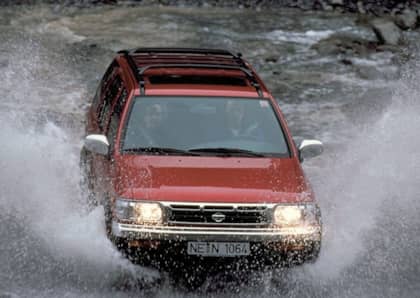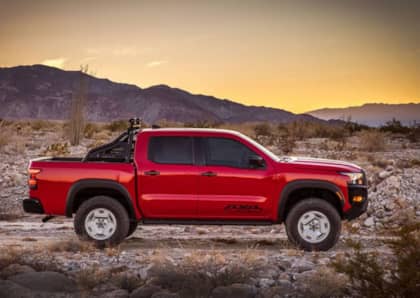The 2005-2012 Nissan Pathfinder Battled The Chevrolet Tahoe, GMC Yukon, and Ford Explorer For SUV Dominance
In the mid-2000s, Nissan did an abrupt about-face with its flagship SUV, the Pathfinder. After nearly two decades of design that favored off-road chops and a modest, mid-size footprint, the Nissan Pathfinder was moved over to the same platform used by the brand's range of pickup trucks.

Not only did this transition the sport-utility vehicle from unibody back to body-on-frame, but it also significantly boosted its dimensions in almost every category. Larger, heavier, more spacious, and much more powerful, the 2005-2012 Nissan Pathfinder shifted the model upwards in terms of price and capability, hewing closer to full-size than it ever had before.

Dubbed the 'R51' internally, the 2005-2012 SUV marked a move away from the Pathfinder's past as an off-road-first vehicle, and instead pushed it in front of families who previously had to hit up other brands when their brood required the addition of a third row of seating. It was the beginning of the end for Nissan's all-terrain sport-utility aspirations, but one that proved an accurate prediction of where the burly 4x4 market was truly heading.
Go Big Or Go Home
Despite strong initial sales, towards the end of its eight year run in the U.S. market the second-generation Nissan Pathfinder was starting to slump. Most other automakers had jumped on the SUV bandwagon by the year 2000, and with more modern options flooding the market the somewhat dated chassis and smaller interior sported by the Pathfinder was a harder sell.

Fortunately for Nissan, it had just dumped a ton of money into the 'F-Alpha' platform, which was intended to underpin both the Frontier mid-size pickup and the Titan full-size truck. This versatile body-on-frame setup was perfect for introducing the first branch of the Pathfinder's redesign: the Pathfinder Armada, a huge three-row hauler that looked every inch the rolling spectacle that its name suggested.

Arriving in 2004, it brought with it the same 310 hp, 5.6L V8 found under the hood of the Titan, and shuffled in beside the Ford Expedition and the Chevrolet Suburban in terms of its footprint.

The following year, the standard version of the Pathfinder hit the scene (at the same time that its larger sibling lost its 'Pathfinder' badging and became known simply as the Armada). Looking very much like a 7/8ths version of the Armada, the new vehicle was also significantly larger than the one it replaced, boasting nearly 5 inches of additional length that incorporated 6 inches of extra wheelbase.

Most of that embiggening went into assuring owners that they'd have plenty of interior space, with a third row offered for the first time as well as a more generous stretch-out for second row riders.
V8 In The Mix
Initially, the 2005 Nissan Pathfinder didn't bring a ton of extra power to back its increased bulk. The new 4.0L V6 under its hood provided 266 horses, which was only 26 hp extra compared to the older model had on offer, but it did come with a more modern five-speed automatic transmission to replace the older four-speed (with a manual gearbox no longer an option in North America).

Sensing the need for more grunt to better combat the V8-powered Toyota 4Runner of the era, as well as vehicles like the class-leading Ford Explorer, the Pathfinder eventually found itself in possession of the Armada's 5.6L eight-cylinder engine for the 2008 model year (which also coincided with a slight refresh for the vehicle).

Towing capacity for the Pathfinder V8 grew to 7,000 lbs, thanks in large part to its 388 lb-ft of torque.
The Final Off-Road Edition
Although the truck was now indisputably more of a family hauler than a serious off-road rig, Nissan made sure to continue to offer 4x4 editions of the model that could at the very least handle trails that weren't too tight for its longer wheelbase.

These were headlined by the 'E Off-Road 4X4 trim, which installed goodies like low-range gearing, Rancho shocks, beefier tires, hill descent control, and additional ground clearance.

While it's true that the Pathfinder was still quite capable at munching down on the rough stuff, its sheer bulk made it a liability on the trail in a way that the older versions of the SUV hadn't been.

Clearly, Nissan had put most of its 4x4 eggs in the Xterra basket, as this smaller, more hardcore sport-utility was closer in size to the previous Pathfinder and priced to entice budget-conscious four-wheel drive fans.
Transition To Crossover Country
Initial interest in the third-generation Pathfinder was strong, but by 2008 its sales had dropped by 50 percent, followed by another precipitous tumble the year after. It seems that the almost, but not-quite full-size segment occupied by Nissan's SUV was a little too crowded, especially as three-row crossovers began to overtake traditional sport-utility vehicles through better fuel efficiency with no sacrifice in practicality.

Nissan was paying attention to this trend, and for 2013 the Pathfinder underwent yet another dramatic personality change that saw it switch to a front-wheel drive/all-wheel drive platform borrowed from the brand's minivan/sedan side of the business. This proved to be the right move, as customer interest rebounded with a vengeance and families poured back into showrooms to snag a less thirsty, but still roomy version of the SUV. It also marked the end of the Pathfinder as a legitimate off-road option, with only the massive Armada continuing down the four-wheel drive, body-on-frame path.

Today, the 2005-2012 Nissan Pathfinder occupies an overlooked spot in the world of used sport-utility vehicles. Plagued by reliability concerns on early models (with 2009-2012 models the safest bet), it doesn't have nearly the following of the 4x4 SUVs that came before it. Instead, it's most often deputized for tow duty or as a daily driver for those who fuel budgets can absorb its thirst habits, and it lives on as an inexpensive, body-on-frame alternative to more popular options like the Explorer, the 4Runner, or the Chevrolet Trailblazer—albeit one without nearly the same level of enthusiast support as the R50 or WD-series Pathfinders.
More From Driving Line
- The 1996-2004 Nissan Pathfinder is your cheap 4x4 SUV alternative to the Toyota 4Runner
- Charting Nissan's progression from the Alpha-T Concept to the Nissan Titan pickup
- The Nissan Xterra SUV is the cheap Jeep Wrangler fighter 4x4 fans have forgotten about
- The Nissan Hardbody was a pioneering compact pickup in the 1980s and 1990s











